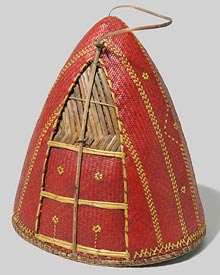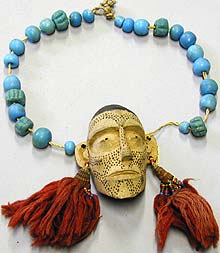John Henry Hutton
Hutton was born in 1885 in Yorkshire and was educated in Essex and at Worcester College, University of Oxford where he took a third class degree in modern history in 1907. In 1909 he joined the Indian Civil Service and spent most of his administrative career in Assam, on the border between India and Burma, particularly in the Naga Hills.
He worked as a Political Officer and Deputy Commissioner in Assam. In 1920 he was appointed the Honorary Director of Ethnography for Assam. Part of his job was to travel within Assam, and in 1923-1934 he travelled to 'previously unvisited Naga territory', possibly during one of his regular tour duties as Deputy Commissioner. Such tours lasted two or three months, the Commissioner moving between Inspection Bungalows, settling legal and land disputes and reporting on the state of roads, bridges and bungalows. Official tour diaries were written for such journeys and the Pitt Rivers Museum has copies of several of Hutton's. An idea of how difficult such journeys were can be got from the following diary account, written by Henry Balfour when he was visiting Hutton in Nagaland in 1922:
September 19 1922. '... We walked back to KHONOMA, partly by a different route, up another rough flight of 1000 or more stone steps into the village, through which we went on to the bungalow, arriving awfully tired. It came on to rain torrentially, but after waiting some time at the bungalow, we decided to ride on to JOTSOMA, in spite of the rain. The going was appallingly slippery + it was not easy to keep the horses on their legs on the narrow ledge-like track. We had to dismount at the wooden bridge + stone steps, which were too slippery to negotiate mounted. Most of the way it is rather 'trick-riding' along a ledge track with a nearly sheer fall on one side. Arrived at JOTSOMA, there was much difficulty in finding men to hold the horses, + this caused a delay. ...' [Balfour field diary, 1922 Naga Hills, India, Balfour ms collection, PRM]
Balfour described Hutton as 'the greatest authority on the Naga Hills in general'. [Balfour, 1938: 216] Hutton himself described how his professional career as an Indian civil servant fed his anthropological work:
'The account of the Semas given in this book has been compiled at Mokokchung and at Kohima in the Naga Hills, during an eight years' acquaintance with them, during which I have learnt to speak the language fairly fluently and have been brought into contact with the life of the individual, the family, and the community more or less continuously and from many angles. For there is hardly any point of tribal custom which is not sooner or later somehow drawn into one of the innumerable disputes which the local officer in the Naga Hills is called upon to settle, and it is my experiences in this way which constitute my credentials in writing this volume.' [Hutton, 1921 [a]: vii]
In 1921 he published two monographs on the Angami and Sema Nagas, which earned him a D.Sc from the University of Oxford. As well as writing about the Nagas he also collected a great deal of their material culture, in the end amassing a very substantial collection which he first loaned, and then donated, to the Pitt Rivers Museum. It is hard to envisage his collection without also taking into account the companion collection, also given to the Museum, of James Phillip Mills (a I.C.S. colleague from the Naga Hills). Hutton and Mills' ethnographic work is really only understandable when seen as composite whole, rather than as two separate author's contributions. The same is true of their collections. They both took account of the things the other man had collected when selecting material to donate to the PRM. It is unsurprising that Mills wished their joint collection to be known as the Hutton-Mills collection (and not considered as two separate collections).
In 1929 he was appointed Census Commissioner for India. In an obituary of Hutton it was remarked:
'Hutton's greatest opportunity to apply anthropological knowledge to the practical business of government came with his appointment as Census Commissioner ... In this important position he co-ordinated the collection of anthropologically relevant data throughout India, devising questionnaires and encouraging officials of the Indian Civil Service to produce descriptive accounts of the tribes ... with which they were familiar.

India, Nagaland: Chang Naga. Canework hat ornamented with feathers. Donated by John Henry Hutton in 1919 or 1923
(1923.84.697, copyright PRM)
He continued to work for the Indian Civil Service until 1936 when he resigned. The following year he was appointed to the William Wyse Chair of social anthropology at Cambridge University. His distinction as an anthropologist was recognized by the award of the Rivers memorial medal of the Royal Anthropological Institute in 1929 and the presidency of the Institute in 1944 and 1945. He gave the Frazer memorial lecture in 1938, and in 1932 won the silver medal of the Royal Society of Arts. He retired from the professorship in 1950, at the age of sixty-five. He died in 1968.
The DNB summarised his anthropological career thus:
It is clear from a number of sources that Hutton became very involved with the lives, diverse histories, and cultures of the various tribal groups who lived in the eastern Himalayas. He became interested in their connections with other megalithic cultures in south-east Asia and Oceania, and wrote important articles on the possible links between them. He provided important clues to the function of head-hunting in the area. He worked closely with, and guided, his younger colleague John Philip Mills, and inspired the next generation of experts in the area, particularly Christoph von Fürer-Haimendorf. The monographs of these three writers covered most of the major Naga tribes, the Angami, Sema, Lhota, Ao, Rengma, and Konyak. Hutton's ethnography and deep knowledge of the people he wrote about evidently set a very high standard. As well as these extensive writings, Hutton, Mills, and [Fürer-]Haimendorf set out to collect objects, from the everyday to the ornate. Most of Hutton's extensive collections are in the Pitt Rivers Museum at Oxford, where many of his photographs and some rare wax cylinder recordings which he made are also to be found. Combined with the detailed reports of his tours and other administrative papers in the Oriental and India Office collections at the British Library, his work helped to make the Nagas one of the best documented tribal groups in the world. This is particularly important since he was working just at the point when an ancient and forest-dwelling population, enormously rich in its material culture and varied in every way, was being incorporated into the British empire.
Further reading:
Jacobs, Julian. 1990 The Nagas: Hillpeoples of Northeast India Edition Hansjorg Mayer, Stuttgart
Fürer-Haimendorf, C. von. 'Obituary: John Henry Hutton 1885-1968' Man 1968 66-7
Hutton, John Henry. 1921 The Angami Nagas Macmillan London
Hutton, John Henry. 1921 The Sema Nagas Macmillan London
Hutton, John Henry 1921 'Introduction' in James Philip Mills, The Lhota Nagas Macmillan London
Alison Petch
August 2005



